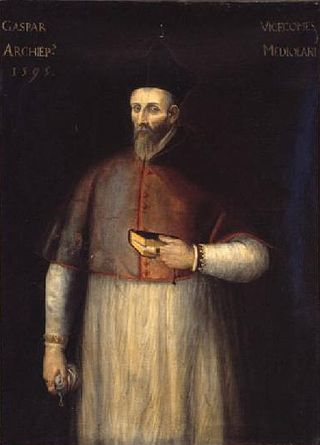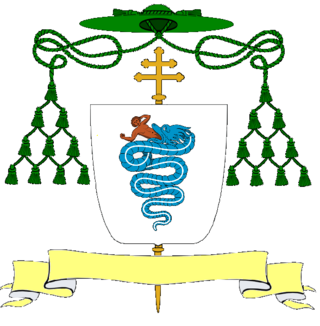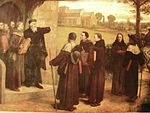
Matilda of Tuscany, also referred to as la Gran Contessa, was a member of the House of Canossa in the second half of the eleventh century. Matilda was one of the most important governing figures of the Italian Middle Ages. She reigned in a period of constant battles, political intrigues and Roman Catholic excommunications, and was able to demonstrate an innate and skilled strategic leadership capacity in both military and diplomatic matters.

The Visconti of Milan are a noble Italian family. They rose to power in Milan during the Middle Ages where they ruled from 1277 to 1447, initially as Lords then as Dukes, and several collateral branches still exist. The effective founder of the Visconti Lordship of Milan was the Archbishop Ottone, who wrested control of the city from the rival Della Torre family in 1277.

The Archdiocese of Milan is a Latin Church ecclesiastical territory or archdiocese of the Catholic Church in Italy which covers the areas of Milan, Monza, Lecco and Varese. It has long maintained its own Latin liturgical rite usage, the Ambrosian rite, which is still used in the greater part of the diocesan territory. Among its past archbishops, the better known are Ambrose, Charles Borromeo, Pope Pius XI and Pope Paul VI.

Conrad II of Italy, also known as Conrad (III) (12 February 1074 – 27 July 1101), was the Duke of Lower Lorraine (1076–1087), King of Germany (1087–1098) and King of Italy (1093–1098). He was the second son of Holy Roman Emperor Henry IV and Bertha of Savoy, and their eldest son to reach adulthood, his older brother Henry having been born and died in the same month of August 1071. Conrad's rule in Lorraine and Germany was nominal. He spent most of his life in Italy and there he was king in fact as well as in name.

Brianza is a geographical, historical and cultural area of Italy, at the foot of the Alps, in the northwest of Lombardy, between Milan and Lake Como.

Saint Arialdo is a Christian saint of the eleventh century. He was assassinated because of his efforts to reform the Milanese clergy.
Anselm III was the archbishop of Milan from his consecration on 1 July 1086 to his death on 4 December 1093. He reestablished order in the Ambrosian see after more than a decade of fighting between the pataria and the religious authorities and confusion over the succession to the bishopric.
Arnulf III was the Archbishop of Milan from his election on 6 December 1093 to his death in 1097. He succeeded Anselm III only two days after his death. Along with Anselm III and Anselm IV, he was one of a trio of successive archbishops of Milan to side with the pope against the emperor in the late 11th and early 12th century.

Giovanni Visconti (1290–1354) was an Italian Roman Catholic cardinal, who was co-ruler in Milan and lord of other Italian cities. He also was a military leader who fought against Florence, and used force to capture and hold other cities.

Saint Erlembald was the political and military leader of the movement known as the pataria in Milan, a movement to reform the clergy and the church in the Ambrosian diocese.

Ottone Visconti was Archbishop of Milan and Lord of Milan, the first of the Visconti line. Under his rule, the commune of Milan became a strong Ghibelline city and one of the Holy Roman Empire's seats in Italy.

The Synod of Worms was an ecclesiastical synod and imperial diet (Hoftag) convened by the German king and emperor-elect Henry IV on 24 January 1076, at Worms. It was intended to agree a condemnation of Pope Gregory VII, and Henry's success in achieving this outcome marked the beginning of the Investiture Controversy.
Guido da Velate was the Archbishop of Milan from 1045 until his death, though he had simoniacally abdicated in 1067. He had been chosen as successor to Aribert by the people in opposition to the choice of the noblesse and confirmed as archbishop by the Emperor Henry III.
Landulf of Milan was a late eleventh-century historian of Milan. His work Historiae Mediolanensis contains a proportion of pure invention, as well as gross inaccuracies. He is called Landulf Senior to distinguish him from the unrelated chronicler of Milan Landulf Junior.

Gaspare Visconti was the Archbishop of Milan from 1584 to 1595.
Landulf of Saint Paul, called Landulf Junior to distinguish him from Landulf Senior, was a Milanese historian whose life is known entirely from his main work, the Historia Mediolanensis. He presents a unique and important point of view from the conflict-ridden years of 1097–1137 in Milan. He thrice sojourned in France while his ecclesiastical faction—the Pataria—was out of favour in Milan, and there learned under some of the leading philosophers of western Europe. After 1113, Landulf's primary ambition was to regain the priesthood in the church of San Paolo which he had lost, and to this end he communicated with popes and emperors. He played a role—large in his own account—in the election of Conrad of Hohenstaufen as King of Italy in 1128.
Landulf of Carcano was the archbishop of Milan, as Landulf II, from 979 until his death.
Herbert Edward John Cowdrey (1926–2009), known as H. E. J. Cowdrey or John Cowdrey, was an English historian of the Middle Ages and an Anglican priest. He was elected priest of St Edmund Hall, University of Oxford, in 1956. He resigned the chaplaincy in 1976, but continued to teach medieval history there until 1994, when he retired and was elected emeritus fellow. He was also a Fellow of the British Academy. A leading expert on the Gregorian reforms, his most important work is the monograph Pope Gregory VII, 1073–1085, considered a masterpiece "unlikely to be surpassed".

Giovanni III Visconti was the Italian Catholic Archbishop of Milan.
John X, known as Giovanni da Besate or Giovanni Vincenzo, was the archbishop of Ravenna from 983 until 998.













